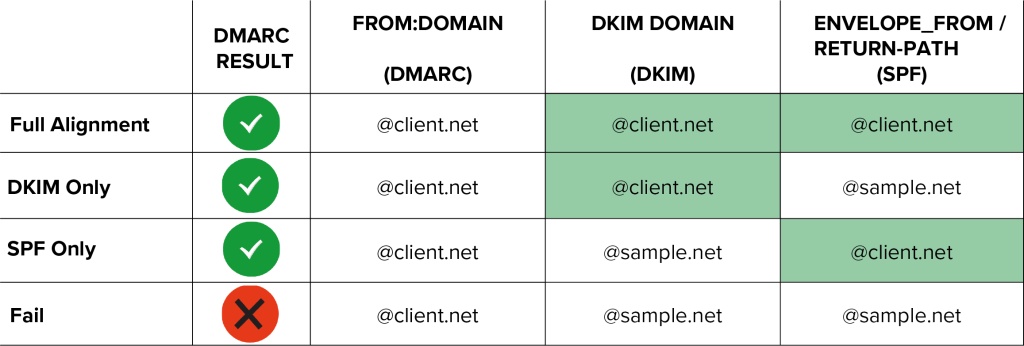
In the ever-evolving landscape of email marketing, understanding the nuances of DKIM authentication failures is paramount. As email marketers, we’re entrusted with the task of not only crafting compelling messages but also ensuring their safe and reliable delivery to our audience’s inboxes.
However, encountering a “DKIM FAIL” can throw a wrench into our well-laid plans, potentially impacting deliverability and tarnishing our brand’s reputation. Fear not, though, for armed with knowledge and proactive measures, we can navigate through these challenges.
Let’s decode the intricacies of DKIM authentication together!
Short Answer: You’ve to use an email warmup to build up your email reputation to not run into DKIM Fail.
What does a failed DKIM score mean?
“DKIM FAIL” refers to an issue encountered with email authentication using DomainKeys Identified Mail (DKIM). DKIM failure occurs when the DKIM authentication check fails due to inconsistencies between the domains listed in the DKIM signature header and the “from” header, as well as discrepancies in the key pair values.
This specific error, “dkim=fail (no key for signature),” often stems from a misconfigured, invalid, or absent public key in your DNS settings.
What happens when DKIM Fail?
When DKIM fails, it indicates that the message’s integrity has been compromised, making it untrustworthy. This can occur if the message is altered by a third party during transmission or if modifications are made by the recipient’s mail server. Let’s explore the reasons behind DKIM failures.
Why DKIM Fail?
Sometimes, DKIM verification fails, leaving emails vulnerable. Here are top 5 reasons for DKIM failure:
1. DKIM Record Syntax Errors

Manually setting up a DKIM record for your domain poses the risk of implementation errors. Syntax mistakes in your DNS entries can lead to authentication failure, resulting in DKIM failure.
2. DKIM Signature Alignment Failure

When both DMARC and DKIM are set up for your domain, DKIM verification requires alignment between the domain value in the “d=” field on the DKIM signature and the domain in the “From” address.
This alignment can be strict, requiring exact matches, or relaxed, allowing organizational matches. A DKIM failure may happen if the DKIM signature header domain doesn’t match the domain in the “From” header, often indicating potential domain spoofing or impersonation attempts.
3. No DKIM Configuration for Third-Party Services

When using different email services, ask them to set up DKIM for your domain for outbound emails. Ensure they handle DKIM setup for your custom domains or subdomains. They’ll either handle everything or give you instructions. If not set up correctly, DKIM might fail, so talk openly with your provider.
Note: Some servers adding formatted footers can contribute to DKIM failure.
4. Mail Server Communication Issues

DNS resolution timeouts, network problems, or port blocking can lead to DKIM failure. Ensure stable server communication.
5. Message Body Modifications by MTAs (Mail Transfer Agents)

Unlike SPF, DKIM doesn’t check the sender’s IP address or return-path. Instead, it verifies that the message content remains unchanged during transit. However, some MTAs or forwarding agents might alter the message body inadvertently, causing DKIM failure. Formatting emails is typically automated to ensure readability for recipients.
Regardless of the cause, DKIM failures demand attention to ensure email security.
How to Address DKIM Failures?
1. Check and Correct DNS Records

Ensure that your DKIM DNS records are correctly configured. Double-check that the public key associated with DKIM is accurately published in your domain’s DNS records as a TXT record. Any inaccuracies or inconsistencies in these records can lead to DKIM failures.
2. Maintain Signature Alignment

Confirm that the DKIM signature aligns with the sender’s domain. It’s critical to ensure that the domain specified in the DKIM signature matches the domain in the “From” header of your emails. This alignment is essential for successful DKIM authentication and to prevent verification failures.
3. Minimize Message Modification

Avoid making modifications to the email message body or headers after signing with DKIM. Even slight alterations can invalidate the DKIM signature, leading to verification failures. Consistently preserving the integrity of the signed message content is vital for reliable DKIM authentication.
4. Implement DMARC Policies

Deploy DMARC (Domain-based Message Authentication, Reporting, and Conformance) policies for your domain. DMARC provides comprehensive email authentication and helps prevent email spoofing and phishing attacks by specifying how receivers should handle emails that fail authentication checks. By enforcing DMARC policies, you can significantly reduce DKIM failures and enhance overall email security.
5. Regular Key Rotation

Implement a regular key rotation schedule for your DKIM keys, typically every 6 to 12 months. This practice enhances security by ensuring that older keys are not used indefinitely and reduces the risk of DKIM failures due to compromised or outdated keys.
By prioritizing these best practices, you can effectively address DKIM failures and improve the reliability and security of your email communications.
What You Absolutely Cannot Overlook!
While encountering a DKIM failure may seem daunting at first, it’s important to view it as an opportunity rather than a setback. By resolving DKIM issues, you’re not only enhancing the security and deliverability of your emails but also laying the groundwork for a more effective email marketing strategy.
As you move forward from this hurdle, consider automated email warm-up as the next crucial step in optimizing your email campaigns. By gradually increasing your sending volume and establishing a positive sender reputation, you’ll ensure that email warmup will consistently let your emails reach the intended inbox, fostering stronger engagement and conversion rates.

Remember, in the dynamic world of email marketing, every challenge presents a chance for growth. Embrace the process of refining your email practices, and you’ll find yourself consistently delivering valuable content to your audience’s inbox.
Keep innovating, keep optimizing, and keep forging stronger connections through email. Your journey towards email marketing excellence continues, and with each step forward, your success awaits with email warm up.
Leave a Reply